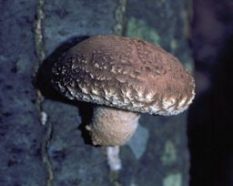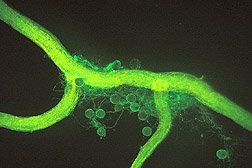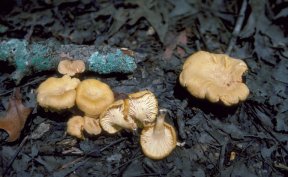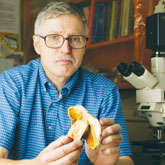Fungus hunt
Scientists are collecting information to create a family tree for fungi (and mushrooms).
By Emily Sohn
There are lots of ways to enjoy mushrooms. You can put portabellas on pizzas. You can sauté shitakes with butter and garlic. You can hunt for morels in the woods. Or you can study porcinis under a microscope.
 |
|
Shitake mushroom.
|
| Robert L. Anderson, USDA Forest Service, www.forestryimages.org |
Scientists do all of these things—and more. Mushrooms belong to a major group of organisms called fungi. Not quite animals and not quite plants, fungi are turning out to be full of mysteries and surprises.
Mushrooms pop up in forests at certain times of year in various places all over the world and then disappear completely without warning. Some are as big as a car. Others are too small to see without a magnifier. Their colors range from bright orange to purple to green.
To add to the intrigue, it turns out that fungi are more closely related to animals than they are to plants—even though they look more like plants. Some types even seem to have ingredients that fight cancer, though others can kill you.
“Once you get to know them, they really become interesting,” says mushroom researcher David McLaughlin. More than just an ordinary mushroom lover, McLaughlin is curator of fungi at the Bell Museum of Natural History in Minneapolis. He’s also a professor at the University of Minnesota in St. Paul.
McLaughlin and other fungi experts estimate that between 1 million and 1.5 million species of fungi exist on Earth. Yet, only about 10 percent of them have been identified and named.
“It’s amazing how little is known,” he says, “and how much there is to discover.”
Filaments and spores
A few basic traits tie all fungi together. Most are made up of threadlike structures called filaments. They feed on dead and dying organisms. To reproduce, they send out spores instead of seeds. And the mushrooms that we see (and buy at the store) are just the fruits of fungi. Most of a fungus stays hidden underground.
 |
|
This microscopic view of a fungus that grows on corn roots shows its threadlike filaments and spores (round bodies). This sample has been dyed so that it glows green to make it more visible.
|
| Sara Wright, USDA Agricultural Research Service |
Across the fungus kingdom, however, there’s a large amount of variety—in looks, lifestyle, and flavor. Some are delicious, while others are poisonous. Some grow on trees, while most grow on the ground.
To get a better idea of exactly what’s out there, McLaughlin and his coworkers are pulling together all the data published about mushrooms over the last 40 years. They’re also building large computer databases to hold the information they collect.
In the end, the researchers hope to piece together a fungal family tree. The tree should help explain how various types of fungi are related to each other and how different species developed over the course of evolution.
“We’re trying to fill in holes in the data so that people can understand how fungi evolved,” McLaughlin says.
There are also practical reasons for creating a fungal family tree. Hundreds of kinds of fungi cause diseases in people, including ringworm and athlete’s foot. Some 5,000 types cause diseases in plants. Understanding which species are related to one another allows researchers to predict which ones might cause diseases and which ones might respond to certain treatments. Also, knowing how much diversity is out there is the first step in knowing if and when certain species start disappearing.
Diversity and DNA
McLaughlin uses various features of fungi to put them into categories, starting with the shape, size, color, texture, smell, feel, habitat, and manner of growth of the fungus itself and details of its cells, fruiting bodies, spores, hairs, and other structures.
Other researchers use modern advances in technology to classify fungi. By comparing the genetic material DNA in two different species, scientists can determine how closely related these species are.
 |
|
Chanterelle mushrooms.
|
| Theodor D. Leininger, USDA Forest Service, www.forestryimages.org |
In one recent study, McLaughlin says, researchers took samples of soil from high elevations in the Rocky Mountains. They found fungal DNA in the soil and were able to use it to identify an entirely new type of fungus.
Taking a closer look at mushrooms is also revealing how much more there is than meets the eye in the wide world of fungi. “With new techniques, we’ve been able to say, ‘Oh my. We thought these were the same things. But now that we look closer, we’re able to say they’re not the same thing,'” McLaughlin says. “Everyone assumes that if it’s shitake, it’s a shitake. Well, a shitake is not just one thing.”
The porcini group, too, appears now to include at least 35 species living across the Northern Hemisphere, not one or two species as previously thought. That’s important because people have been using porcinis as medicine for thousands of years. These mushrooms have also been getting attention lately for their ability to destroy tumor cells. It’s possible that not all types of porcinis provide the same benefits.
 |
|
Mushroom specialist David McLaughlin is working with medical researchers to see if certain mushrooms can prevent cancer.
|
| Photo by Tim Rummelhoff, University of Minnesota. |
Unfortunately, most of the studies previously published about these mushrooms are useless now, McLaughlin says, because the scientists didn’t keep specimens of what they were looking at. It’s hard to tell exactly which particular type of mushroom they were studying.
Creating a new, large database will help researchers accurately classify the fungi they are working on. Having such specific information about these fungi will make their results more useful to other scientists.
So, the fungi hunt continues, whether it’s to learn more about these fascinating organisms or simply to identify something good to eat.
Be careful, however. Don’t eat any mushrooms that you find in the woods without checking with a teacher, parent, or mushroom expert first. Some mushrooms are poisonous enough to kill you.
Going Deeper:







